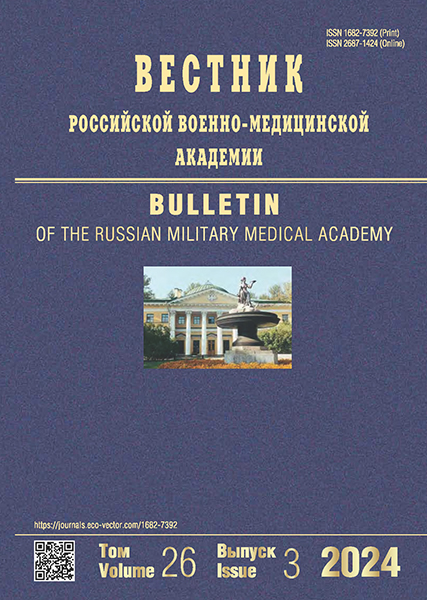女性军人的铁缺乏症和日常体力活动
- 作者: Kovalev A.V.1, Tishko V.V.1, Polyakov A.S.1, Glavinskaya A.M.1, Egorova E.N.1, Bulankov Y.I.1
-
隶属关系:
- Kirov Military Medical Academy
- 期: 卷 26, 编号 3 (2024)
- 页面: 411-420
- 栏目: Original Study Article
- ##submission.dateSubmitted##: 22.11.2023
- ##submission.dateAccepted##: 06.06.2024
- ##submission.datePublished##: 06.09.2024
- URL: https://journals.eco-vector.com/1682-7392/article/view/623700
- DOI: https://doi.org/10.17816/brmma623700
- ID: 623700
如何引用文章
详细
对年轻女军人缺铁状况的临床表现及其与日常体力活动水平的关系进行了评估。S.M. Kirov Military Medical Academy 机构的学院治疗部对 135 名健康年轻女军人的缺铁状况进行了横断面单阶段研究。为了诊断铁缺乏症,对一般血细胞计数和血铁蛋白水平进行了评估,使用缺铁快速诊断问卷评估了全血检查和血铁蛋白水平以及缺铁临床症状的存在。此外,还使用国际体力活动调查表评估了每天的体力活动水平。结果发现,有 48 人(35.6%)被诊断为潜伏性缺铁,46 人(34%)被诊断为缺铁性贫血。根据临床数据,健康组中有16名(39%)女性、潜伏性缺铁组中有28名(58.3%)女性和缺铁性贫血组中有31名(67.4%)女性可能患有缺铁疾病(p<0.001)。据统计,只有健康 组和缺铁性贫血组在以下指标上有更明显的缺铁症状:乏力、疲劳加剧(p = 0.006)、情绪低落(p = 0.007)、白天嗜睡(p = 0.006)、工作日结束时腰部沉重(p = 0.016)、无光泽、脆弱、脱发、早发白发(p < 0.001)。日常体力活动水平表明,所有研究组都不存在低动力症。在日常高强度和非高强度体育活动的持续时间和频率以及步行的持续时间方面,没有发现统计学上的显着差异。因此,缺铁状态在年轻女军人中很常见。在潜伏性缺铁阶段,就会出现缺铁症状。同时,从统计学角度看,缺铁对日常体力活动的水平并无明显影响。
全文:
作者简介
Aleksei V. Kovalev
Kirov Military Medical Academy
编辑信件的主要联系方式.
Email: vmeda-nio@mil.ru
ORCID iD: 0000-0001-5884-2057
SPIN 代码: 3478-3858
Scopus 作者 ID: 56865442200
Researcher ID: M-7992-2016
graduated in a military academy
俄罗斯联邦, Saint PetersburgValery V. Tishko
Kirov Military Medical Academy
Email: vtishko@gmail.com
ORCID iD: 0000-0003-4696-3569
SPIN 代码: 9488-5068
Scopus 作者 ID: 56803890800
Researcher ID: JDC-5638-2023
MD, Dr. Sci. (Med.), associate professor
俄罗斯联邦, Saint PetersburgAleksei S. Polyakov
Kirov Military Medical Academy
Email: doctorpolyakov@gmail.com
ORCID iD: 0000-0001-9238-8476
SPIN 代码: 2700-2420
Scopus 作者 ID: 56583551700
Researcher ID: M-4229-2016
MD, Cand. Sci. (Med.)
俄罗斯联邦, Saint PetersburgAlesya M. Glavinskaya
Kirov Military Medical Academy
Email: a.glavinskaya@mail.ru
ORCID iD: 0009-0001-2186-7768
head of cytochemical clinical laboratory
俄罗斯联邦, Saint PetersburgElizaveta N. Egorova
Kirov Military Medical Academy
Email: egorovaelisaveta@mail.ru
ORCID iD: 0009-0008-3423-7790
SPIN 代码: 4067-4160
MD, Cand. Sci. (Med.)
俄罗斯联邦, Saint PetersburgYury I. Bulankov
Kirov Military Medical Academy
Email: Dr.Bulankov@mail.ru
ORCID iD: 0000-0001-9004-6907
SPIN 代码: 7997-0230
Scopus 作者 ID: 6506525191
MD, Dr. Sci. (Med.), associate professor
俄罗斯联邦, Saint Petersburg参考
- The global prevalence of anaemia in 2011. WHO. 2011;1–48.
- WHO guideline on use of ferritin concentrations to assess iron status in individuals and populations. WHO. 2020. 82 р.
- Looker AC, Dallman PR., Carroll MD, et al. Prevalence of iron deficiency in the United States. Jama. 1997;277(12):973–976. doi: 10.1001/jama.277.12.973
- Barton JC, Wiener HH, Acton RT, et al. Prevalence of iron deficiency in 62,685 women of seven race/ethnicity groups: The HEIRS Study. PLoS One. 2020;15(4):1–16. doi: 10.1371/journal.pone.0232125
- Cappellini MD, Musallam KM, Taher A.T. Iron deficiency anaemia revisited. J Intern Med. 2020;287(2):153–170. doi: 10.1111/joim.13004
- Ko CW, Siddique SM, Patel A, et al. AGA clinical practice guidelines on the gastrointestinal evaluation of iron deficiency anemia. Gastroenterology. 2020;159(3):1085–1094. doi: 10.1053/j.gastro.2020.06.046
- Tarancon-diez L, Genebat M, Roman-enry M, et al. Threshold ferritin concentrations reflecting early iron deficiency based on hepcidin and soluble transferrin receptor serum levels in patients with absolute iron deficiency. Nutrients. 2022;14(22):4739. doi: 10.3390/nu14224739
- Zeder C, Moretti D, Galetti V, et al. Threshold ferritin and hepcidin concentrations indicating early iron deficiency in young women based on upregulation of iron absorption. EClinicalMedicine. 2021;39(5):101052. doi: 10.1016/j.eclinm.2021.101052
- Wilson C, Brothers M. Iron deficiency in women and its potential impact on military effectiveness. Nurs Clin North Am. 2010;45(2): 95–108. doi: 10.1016/j.cnur.2010.02.005
- Booth CK, Coad RA, Forbes-Ewan CH, et al. The physiological and psychological effects of combat ration feeding during a 12-day training exercise in the tropics. Mil Med. 2003;168(1):63–70. doi: 10.1093/milmed/168.1.63
- Deruisseau KC, Roberts LM, Kushnick MR, et al. Iron status of young males and females performing weight-training exercise. Med Sci Sports Exerc. 2004;36(2):241–248. doi: 10.1249/01.MSS.0000113483.13339.7B
- Domínguez R, Sánchez-Oliver AJ, Mata-Ordoñez F, et al. Effects of an acute exercise bout on serum hepcidin levels. Nutrients. 2018;10(2):1–22. doi: 10.3390/nu10020209
- Fallowfield JL, Delves SK, Hill NE, et al. Energy expenditure, nutritional status, body composition and physical fitness of Royal Marines during a 6-month operational deployment in Afghanistan. Br J Nutr. 2014;112(5):821–829. doi: 10.1017/S0007114514001524
- Farina EK, Taylor JC, Means GE, et al. Effects of deployment on diet quality and nutritional status markers of elite U.S. Army special operations forces soldiers. Nutr J. 2017;16(1):1–10. doi: 10.1186/s12937-017-0262-5
- Knapik JJ, Farina EK, Fulgoni VL, et al. Clinically diagnosed iron and iodine deficiencies and disorders in the entire population of US military service members from 1997 to 2015. Public Health Nutr. 2021;24(11):3187–3195. doi: 10.1017/S1368980021000495
- McClung JP, Marchitelli LJ, Friedl KE, et al. Prevalence of iron deficiency and iron deficiency anemia among three populations of female military personnel in the us army. J Am Coll Nutr. 2006;25(1):64–69. doi: 10.1080/07315724.2006.10719516
- Yanovich R, Karl JP, Yanovich E, et al. Effects of basic combat training on iron status in male and female soldiers: a comparative study. US Army Med Dep J. 2015:67–73.
- Kovalev AV, Tishko VV, Polyakov AS, et al. The effect of aerobic exercise on the development of iron deficiency in young women. Therapy. 2023;(1):48–54. EDN: HJSCXB doi: 10.18565/therapy.2023.1.48-54
- Blank PR, Tomonaga Y, Szucs TD, et al. Economic burden of symptomatic iron deficiency — A survey among Swiss women. BMC Womens Health. 2019;19(1):1–9. doi: 10.1186/s12905-019-0733-2
- Sim M, Garvican-Lewis LA, Cox GR, et al. Iron considerations for the athlete: a narrative review. Eur J Appl Physiol. 2019;119(7): 1463–1478. doi: 10.1007/s00421-019-04157-y
- Kochneva EV, Kralevska MV. Iron-deficiency conditions and their express diagnostics in everyday clinical practice. Nutrition. 2017;7(2):58–63. EDN: ZBJZQX doi: 10.20953/2224-5448-2017-2-58-63
- Munro MG, Critchley HOD, Fraser IS, et al. The two FIGO systems for normal and abnormal uterine bleeding symptoms and classification of causes of abnormal uterine bleeding in the reproductive years: 2018 revisions. Int J Gynecol Obstet. 2018;143(3):393–408. doi: 10.1002/ijgo.12666
- Lee PH, Macfarlane DJ, Lam TH, et al. Validity of the international physical activity questionnaire short form ( IPAQ-SF ): A systematic review. Int J Behav Nutr Phys Act. 2011;21(8):1–11. doi: 10.1186/1479-5868-8-115
- Mansour D, Hofmann A, Gemzell-Danielsson K. A Review of Clinical Guidelines on the Management of Iron Deficiency and Iron-Deficiency Anemia in Women with Heavy Menstrual Bleeding. Adv Ther. 2021;38(1):201–225. doi: 10.1007/s12325-020-01564-y
- Hallberg L, Rossander-Hulten L. Iron requirements. Am J Clin Nutr. 1991;54(6):1047–1058. doi: 10.1093/ajcn/54.6.1047
- Al-Naseem A, Sallam A, Choudhury S, et al. Iron deficiency without anaemia: A diagnosis that matters. Clin Med J R Coll Physicians London. 2021;21(2):107–113. doi: 10.7861/CLINMED.2020-0582
- Garvican LA, Saunders PU, Cardoso T, et al. Intravenous iron supplementation in distance runners with low or suboptimal ferritin. Med Sci Sports Exerc. 2014;46(2):376–385. doi: 10.1249/MSS.0b013e3182a53594
补充文件






